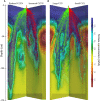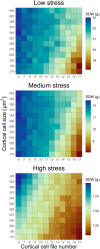Large root cortical cells and reduced cortical cell files improve growth under suboptimal nitrogen in silico
- PMID: 37040571
- PMCID: PMC10315315
- DOI: 10.1093/plphys/kiad214
Large root cortical cells and reduced cortical cell files improve growth under suboptimal nitrogen in silico
Abstract
Suboptimal nitrogen availability is a primary constraint to plant growth. We used OpenSimRoot, a functional-structural plant/soil model, to test the hypothesis that larger root cortical cell size (CCS), reduced cortical cell file number (CCFN), and their interactions with root cortical aerenchyma (RCA) and lateral root branching density (LRBD) are useful adaptations to suboptimal soil nitrogen availability in maize (Zea mays). Reduced CCFN increased shoot dry weight over 80%. Reduced respiration, reduced nitrogen content, and reduced root diameter accounted for 23%, 20%, and 33% of increased shoot biomass, respectively. Large CCS increased shoot biomass by 24% compared with small CCS. When simulated independently, reduced respiration and reduced nutrient content increased the shoot biomass by 14% and 3%, respectively. However, increased root diameter resulting from large CCS decreased shoot biomass by 4% due to an increase in root metabolic cost. Under moderate N stress, integrated phenotypes with reduced CCFN, large CCS, and high RCA improved shoot biomass in silt loam and loamy sand soils. In contrast, integrated phenotypes composed of reduced CCFN, large CCS, and reduced LRBD had the greatest growth in silt loam, while phenotypes with reduced CCFN, large CCS, and high LRBD were the best performers in loamy sands. Our results support the hypothesis that larger CCS, reduced CCFN, and their interactions with RCA and LRBD could increase nitrogen acquisition by reducing root respiration and root nutrient demand. Phene synergisms may exist between CCS, CCFN, and LRBD. CCS and CCFN merit consideration for breeding cereal crops with improved nitrogen acquisition, which is critical for global food security.
© The Author(s) 2023. Published by Oxford University Press on behalf of American Society of Plant Biologists.
Conflict of interest statement
Conflict of interest statement. None declared.
Figures





Similar articles
-
Reduced root cortical cell file number improves drought tolerance in maize.Plant Physiol. 2014 Dec;166(4):1943-55. doi: 10.1104/pp.114.249037. Epub 2014 Oct 29. Plant Physiol. 2014. PMID: 25355868 Free PMC article.
-
Root cortical aerenchyma enhances the growth of maize on soils with suboptimal availability of nitrogen, phosphorus, and potassium.Plant Physiol. 2011 Jul;156(3):1190-201. doi: 10.1104/pp.111.175489. Epub 2011 May 31. Plant Physiol. 2011. PMID: 21628631 Free PMC article.
-
Root cortical aerenchyma enhances nitrogen acquisition from low-nitrogen soils in maize.Plant Physiol. 2014 Oct;166(2):726-35. doi: 10.1104/pp.114.241711. Epub 2014 Jun 2. Plant Physiol. 2014. PMID: 24891611 Free PMC article.
-
Root phenes that reduce the metabolic costs of soil exploration: opportunities for 21st century agriculture.Plant Cell Environ. 2015 Sep;38(9):1775-84. doi: 10.1111/pce.12451. Epub 2014 Nov 17. Plant Cell Environ. 2015. PMID: 25255708 Review.
-
Steep, cheap and deep: an ideotype to optimize water and N acquisition by maize root systems.Ann Bot. 2013 Jul;112(2):347-57. doi: 10.1093/aob/mcs293. Epub 2013 Jan 17. Ann Bot. 2013. PMID: 23328767 Free PMC article. Review.
Cited by
-
Root phenotypes for improved nitrogen capture.Plant Soil. 2024;502(1-2):31-85. doi: 10.1007/s11104-023-06301-2. Epub 2023 Oct 4. Plant Soil. 2024. PMID: 39323575 Free PMC article. Review.
-
Cortical parenchyma wall width regulates root metabolic cost and maize performance under suboptimal water availability.J Exp Bot. 2024 Sep 27;75(18):5750-5767. doi: 10.1093/jxb/erae191. J Exp Bot. 2024. PMID: 38661441 Free PMC article.
References
-
- Atwell BJ. Response of roots to mechanical impedance. Environ Exp Bot. 1993:33(1):27–40. 10.1016/0098-8472(93)90053-I - DOI
-
- Burridge JD, Findeis JL, Jochua CN, Miguel MA, Mubichi-Kut FM, Quinhentos ML, Xerinda SA, Lynch JP. A case study on the efficacy of root phenotypic selection for edaphic stress tolerance in low-input agriculture: common bean breeding in Mozambique. Field Crops Res. 2019:244(107612): 1–11. 10.1016/j.fcr.2019.107612 - DOI
-
- Burton AL, Williams M, Lynch JP, Brown KM. Rootscan: software for high-throughput analysis of root anatomical traits. Plant Soil. 2012:357(1–2):189–203. 10.1007/s11104-012-1138-2 - DOI
Publication types
MeSH terms
Substances
LinkOut - more resources
Full Text Sources

